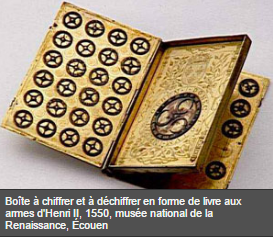 While reading about the French use of encryption during the 16C I ran into a reference that said French Kings borrowed cryptography concepts from Arabs. A little more digging and I found an example by Hervé Lehning in “L’Univers des codes secrets: De l’antiquité à Internet”.
While reading about the French use of encryption during the 16C I ran into a reference that said French Kings borrowed cryptography concepts from Arabs. A little more digging and I found an example by Hervé Lehning in “L’Univers des codes secrets: De l’antiquité à Internet”.
He writes that Muhammad ibn Abbad al-Mu’tamid (المعتمد بن عباد), King of Seville from 1069-1092, used birds in poetry for secret correspondence. For example:
La tourterelle du matin craint le vautour,
Qui pourtant préfère les nuées d’étourneaux,
Ou au moins les sarcelles et les loriots
Qui plus que tout craignent les éperviers.
Matching names of birds to their first letter we get “t v e s l e”, which Lehning contends is the message “tues-le”: kill him
My translation:
The morning dove fears the vulture,
yet who prefers swarms of starlings,
or at least teal and orioles,
who most of all fear the hawk.
Would love to find the original imagery as I imagine the King’s poetry to be highly calligraphic or even a form of pictorial encoding.